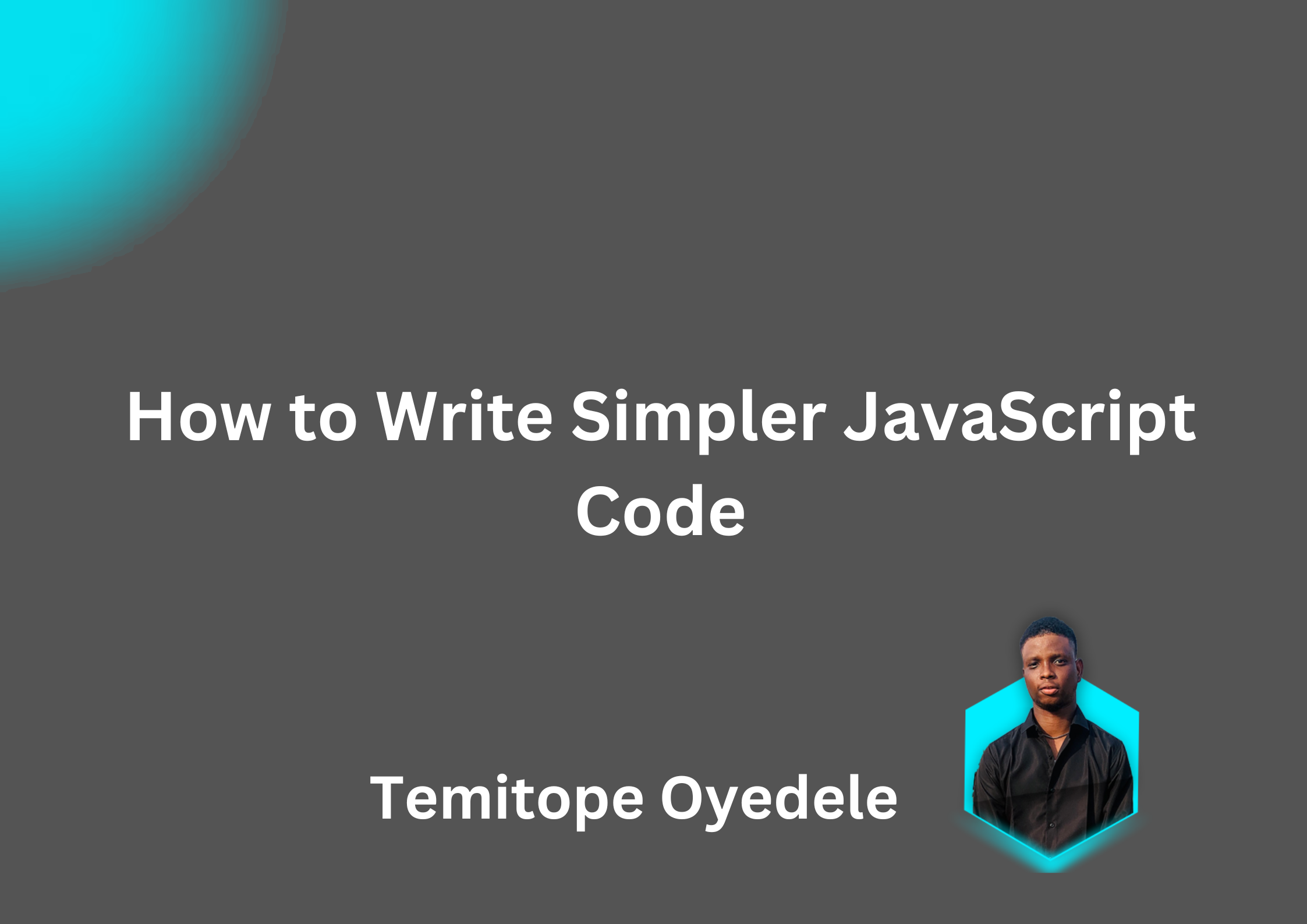As developers, writing clean and maintainable code is the goal. But sometimes, this is hard to achieve when we have a large and bulky codebase that can become complex and difficult to manage.
One way to avoid this is to simplify your code. This can help improve its readability, efficiency, and maintainability.
This article will discuss ten ways to simplify your JavaScript code, making it more readable and maintainable. Let’s jump right in!
Use Arrow Functions
Using Arrow functions is a shorthand way for creating functions in JavaScript. They simplify your code by reducing the boilerplate needed to define a function.
For example, instead of using the function keyword to define a function like this:
function greeings(name){
console.log(Hello, ${name}!);
}
You can use an arrow function like this
const greeting = name => console.log(`Hello, ${name}!`);
Apart from arrow functions having a shorter syntax, they can make your code more concise, easier to read, and less error-prone. This makes it a better choice than using the function keyword
Use Descriptive Variable Names
Using descriptive variable names can make your code more readable and easier to understand. This is much better than using single-letter variable names or abbreviations, as it may not be immediately clear to someone else reading your code what those variables mean.
For example, instead of using:
const x = 10;
Use this:
const numberOfItems = 10;
numberOfItems is much more descriptive than x and will help you (or other developers looking at your code) understand what it's doing.
Use Functional Programming
Functional programming prioritizes the use of pure functions and immutable data structures. Using functional programming techniques can help simplify your code greatly and reduce the risk of bugs and side effects.
For example, instead of modifying an array in place:
const numbers = [1, 2, 3];
numbers.push(4);
You can use the spread operator to create a new array:
const numbers = [1, 2, 3];
const newNumbers = [...numbers, 4];
Using the spread operator helps you prevent unexpected side effects and makes your code more predictable.
When you modify the function in place, you change the original array or object, If another part of your code is relying on that array or object, then it can lead to bugs and unexpected behavior.
On the other hand, using the spread operator creates a new array or object, leaving the original intact. This makes your code more predictable and easier to reason about.
Avoid Nesting Code
Nesting code can make it difficult to read and understand. A better way is to try to flatten your code as much as possible. You can do this by using early returns, ternary operators, and function composition.
For example, instead of nesting if statements:
if (condition1) {
if (condition2) {
// code
}
}
Use early returns:
if (condition1) {
return;
}
if (condition2) {
return;
}
// code
Using early returns here makes our code is more readable and easier to understand because it breaks down each condition into a separate if statement, and returns early if any condition fails.
Early returns can also increase the efficiency of your code by preventing unnecessary computations.
Use Default Parameters
Using default parameters allows you to specify a default value for a function parameter. This can simplify your code by reducing the number of conditional statements you need to write.
For example, instead of using conditional logic to set a default value:
function greet(name) {
if (!name) {
name = 'World';
}
console.log(`Hello, ${name}!`);
}
You can use a default parameter:
function greet(name = 'World') {
console.log(`Hello, ${name}!`);
}
Using a default parameter provides you with a simple way to set default values. But not only that, it makes your code more flexible, less error prone, and also makes your code easier to understand.
Use Destructuring
Destructuring allows you to extract values from arrays and objects and assign them to variables. Doing this can make your code more concise and easier to read.
For example, instead of accessing object properties directly like this:
const person = { name: 'John', age: 30 };
const name = person.name;
const age = person.age;
You can use destructuring:
const { name, age } = { name: 'John', age: 30 };
Using destructuring would be much better than accessing object properties as it helps you quickly understand the purpose of the code, especially when working with complex data structures. It also helps reduce the amount of code you need to write, provides flexibility, results in cleaner code, and also helps avoid naming conflicts
Use Promises
Promises allow you to write asynchronous code in a more readable and predictable way. They simplify your code by avoiding the need for callbacks and enabling you to chain asynchronous operations together.
For example, instead of nesting callbacks:
function getUserData(userId, callback) {
getUser(userId, function(user) {
getPosts(user, function(posts) {
getComments(posts, function(comments) {
callback(comments);
});
});
});
}
You can use promises like this:
function getUserData(userId) {
return getUser(userId)
.then(user => getPosts(user))
.then(posts => getComments(posts));
}
Using promises instead of nesting callbacks can makes the code more concise and easier to read, especially when working with complex asynchronous operations.
Use Array Methods
JavaScript has many built-in methods for manipulating arrays, such as map, filter, reduce, and forEach. Using these methods can make your code more concise and easier to read.
For example, instead of using a for loop to iterate over an array:
const numbers = [1, 2, 3];
for (let i = 0; i < numbers.length; i++) {
console.log(numbers[i]);
}
You can use the forEach method:
const numbers = [1, 2, 3];
numbers.forEach(number => console.log(number));
Using array methods over traditional for loops can make your code more concise, readable, and modular, while also providing better error handling and supporting functional programming techniques.
Use Object Methods
JavaScript objects provide a variety of built-in methods, such as Object.keys, Object.values, and Object.entries. These methods can make your code simpler by reducing the need for loops and conditionals.
For example, instead of using a for loop to iterate over an object:
const person = { name: 'John', age: 30 };
for (const key in person) {
console.log(`${key}: ${person[key]}`);
}
You can use the Object.entries method:
const person = { name: 'John', age: 30 };
Object.entries(person).forEach(([key, value]) => console.log(`${key}: ${value}`));
Just like the array methods, using object methods can make your code more concise, readable, and modular.
Use Libraries and Frameworks
JavaScript has a wide variety of modules and frameworks that may help you create simpler code with less boilerplate.
Examples include React for building user interfaces, Lodash for functional programming, and Moment.js for working with dates and times.
You might consider using a framework/library when:
- When you want to build a complex application with functionalities that can be achieved with a library or framework.
- When you have a tight timeline and need to deliver your project quickly.
- When you want to improve your code's quality and reduce maintenance costs over time.
On the other hand, you may also want to avoid using a framework/library when:
- When your project requirements are simple and require no external tools.
- When you want to have control over your code and avoid dependencies on external tools.
Wrapping Up
Simplifying your code can make it more readable and maintainable. By following these tips, you can write code that is easier to understand and more efficient.
What other tips would you suggest? Don't forget to share if you found this helpful.

